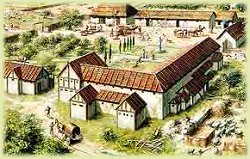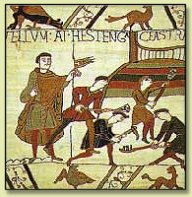History Of The New Forest National Park
how and why the Forest was created
New Forest history
Early New Forest history
This whirlwind account of New Forest history outlines the general events that led to it becoming what it is today, and the particular forces and activities that have shaped the Forest over time.
It’s widely agreed that settlement in the area that today’s New Forest National Park now occupies dates back to the Bronze Age.
Evidence can still be seen today of the earliest methods of cultivation, in the shape of basic field enclosures and the so-called ‘boiling mounds‘, created by large lumps of flint being dropped into water-filled pits in the ground. The flint was heated in a fire immediately prior to being placed in the water, in order to heat it.
Numerous round barrows (early monuments of varying purpose but primarily for burials) can also be seen in many parts of the New Forest, also dating from the Bronze Age.
At this time in history, the area occupied by the present day New Forest National Park was largely dense lowland forest, and it was the early settlers that began shaping the area into its present form by clearing small patches of this woodland for their cultivation needs.
However, the soils of the area were (and still are) largely infertile and too hostile for any serious cultivation of the land to take place – the primary factor that has helped prevent the area becoming characterless open farmland throughout.
After the Bronze Age, the Iron Age occupants of the area increased the limited cultivation opportunities and cleared more woodland. They also built small forts and settlements, a few shaped remains of which can be seen today, particularly around the village of Burley.
But it’s with the arrival of the Romans that the history of the New Forest area experiences a major leap; the first and second centuries AD saw the Romans organising bigger cultivation efforts, building larger settlements and keeping livestock.
Towards 300 AD a relatively serious pottery industry was well established, and to this day fragments of Roman pottery can be found in certain parts of the New Forest, particularly the Amberwood Enclosure area.
By far the largest piece of evidence to support the Roman occupation of the New Forest area is the remains of a large Roman villa (pictured right) at Rockbourne, on the western edge of the present day New Forest National Park.
Post-Roman New Forest history
As time progressed yet further, the Romans were replaced by the Saxons who were periodically invaded by the Vikings.
Despite these interruptions however, the Saxons did manage to establish some degree of organisation throughout the country, including the creation of several ‘kingdoms’. One of these was Wessex with its capital of Winchester, and was under the control of King Alfred. The area of the present day New Forest fell inside this kingdom.
The city of Winchester, now an important city in the country’s history, is located approximately 25 miles to the north-east of the National Park.
The Saxons fought off many invasions from the Vikings, all over the country, but the notorious Viking strength and brutality eventually overpowered the Saxons and leadership was gained when the Viking King Knut (Canute) took power.
With time the Viking rule ended and Knut was replaced with Edward (‘The Confessor‘) who in turn was replaced by Harold, having previously held the position of Earl of Wessex.
At this point in time, the present day New Forest was still just an area of woodland, heathland and bogs and held no special interest to anyone. The area had no name or boundaries and drew no particular attention.
The 1066 invasion of the south of England by William of Normandy (depicted in the Bayeaux Tapestry, shown right) plays a crucial role in the history of the New Forest as we know it today.
The sneaky invasion took place while King Harold was back fighting the Vikings again in the north of the country, following yet another attack by them; Harold’s absence left Wessex and the southern coast of England open for William to invade. On hearing news of the invasion, Harold returned south having defeated the Vikings and was duly defeated and killed by the Normans, at the infamous Battle of Hastings in October of 1066.
William, having now effectively ended the Anglo-Saxon period, was free to take the crown which he did on Christmas Day 1066 at Westminster Abbey, thus starting the period of Norman rule.
The birth of the New Forest
Once established, the new King William I began introducing his influence over the land and had created areas of land throughout the country that would be used as his personal deer and wild boar hunting grounds, a favourite royal pastime as well as ensuring a continued supply of fresh meat to the newly established Crown.
The southernmost of these areas, by all accounts, was one of the most frequented and enjoyed by King William and his men.
This particular area of land was designated and named as the New Forest, in the year 1079.
It’s important to note though, that the word ‘Forest‘ in this context doesn’t reflect the usual meaning of the word. In this case, ‘Forest’ was used to describe an area of land that had been ‘afforested’ (purchased under law) and designated as land to be used for royal privileges, ie hunting.
The name, New Forest, is a direct translation from the Norman Nova Foresta.
All newly afforested areas of land within the country fell under very strict, and much hated, Forest Laws which strictly prohibited any interference by local peasants, or ‘commoners’, with the native animals of the area.
Primarily this meant that the commoners were not allowed to fence their properties, because a fence would interfere with the free running deer and boar. In return, the commoners were given the rights to graze their own animals (ponies, cattle and pigs) on the Open Forest.
It is without doubt that this harsh law has played a massive part in shaping the New Forest as we see it today.
The basis of this system is still in existence today, admittedly somewhat more civilised, in the shape of the New Forest Verderers Byelaws. These laws come under the watchful eye of the New Forest Verderers, who operate a unique court of law in Queen’s House, Lyndhurst.
The Verderers exercise and protect these basic commoner rights, and play a major role in the operation of the New Forest within this modern day National Park.
Sources of reference: New Forest Museum, Battle of Hastings, HCC website.


